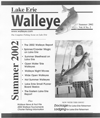Lake Erie and all the other Great Lakes have been put
through a lot of stress due to human activity. We have
dumped chemicals, sewage, and over harvested the fish.
Lake Erie in the sixties was considered almost dead. We began to recognize
the damage we were doing and passed laws to reduce pollution and set limits
on the amount of fish we could harvest. However, we failed to recognize the
most serious threat to the Great Lakes' ecosystem, exotic species. We had
clues over one hundred years ago as to how serious the threat could be but
we failed to recognize the signs.
When the Erie Canal was built in 1812, it opened a path
to Lake Erie and the upper Great Lakes for the sea lamprey. The lamprey
invasion was slow but by the
early 1900's, it became well established and it decimated
the lake trout in the upper Great Lakes, in Lake Erie, lake trout became
extinct. Sea lamprey not only decimated the lake trout, the lake white fish,
and lake sturgeon were greatly impacted by this invader.
The Welland Canal was built in 1829; it opened another
doorway for lamprey, and other non-native fishes, such as the smelt, and the
alewife to expand their ranges into the Upper Great Lakes. We are now so
used to seeing smelt and alewives we have become to accept them as native
fish, however their appearance has been to the detriment to the ecosystem.
The smelt and alewife replaced native forage fish. Smelt are not as
nutritious and actually have had a negative impact on the spawning success
of walleye and any other freshwater game fish that feed on them. Smelt are
rich in the enzyme, thiaminase, which breaks down the B vitamin essential
for the larval development of walleye, lake trout and other fry. The fry are
less robust and more likely to die from environmental stresses and diseases.
If you are old enough to remember the shad die offs
during the 1960's, you will also remember that we introduced salmon (another
exotic species) into the lake to remedy the problem. The margined madtom, a
small baitfish, was accidentally released into the lakes as bait. So we not
only have exotics entering the ecosystem by canals, some are being
introduced by us intentionally or accidentally. Every time this happens and
the animal becomes established they are here forever; and their presence
displaces a native animal.
The invaders who came through these doorways into the
upper Great Lakes were serious and should have awakened us to the problem of
exotic invaders but it didn't. With the globalization of trade, another
vector for species introduction was opened. Ships carrying cargo
need ballast water onboard to optimize the ship's
displacement to keep it from being top heavy when traveling empty. When a
ship loads up with cargo,
(grain or, steel) it dumps the ballast. Ships trading
between ports in Europe, the United States and Canada are constantly filling
their ballast tanks and then emptying them. Every time the tank is filled
from a harbor, the pumps suck in some of the creatures that live there. When
the ballast is dumped usually in another port, the creatures are dumped with
the water. If the conditions are okay for the new arrivals, they flourish.
Usually the transferred creatures into a new ecosystem have no natural
enemies thus increasing their odds for successful survival.
The wake up call for the Great Lakes came in the late
1980's when zebra mussels were discovered near Toledo Ohio. When they were
discovered they already were well established now they are every where.
Since that time 160 new exotic species have been identified in the Great
Lakes and it is estimated that a new species is introduced every six months.
The list of exotics continues to grow.
Since the introduction of sea lamprey, we have spent
hundreds of millions of dollars trying to combat it and to undo the damage
it has done to the lake trout. The sea lamprey control started in 1958 the
US. Fish and Wildlife Service (USFWS) started treating lampreyspawning
sites. The initial treatments cost about $6
million per year and the cost is rising. The USFWS last
year spent over $36 million for lamprey control in the Great Lakes, one
treatment on the Marquette River last year cost $500,000. It has cost
millions of dollars to
treat power stations along the lakes for zebra mussels
that plugged their water intakes. It has cost companies using water directly
from the lakes or Niagara River millions of dollars because zebra mussels
clogged heat exchangers and plumbing. The cost of these two exotics on our
economy is staggering; we have spent hundreds of millions of dollars and
because it will never go away the cost will have to be borne by our children
and generations to come. Sea lampreys are here forever as well as the zebra
mussel, and 159 other exotic species.
After the walleye rebounded in the early 1980's from
overharvest and pollution earlier in the last century again in the walleye
population is in decline. Exotic species continue to affect the ecosystem
and are contributing to the sharp decline in the fishery. Fishery managers
are struggling to keep the walleye and other native fish populations from
collapse. The spiney and fishhook water fleas, which have been introduced in
just the past few years, are displacing native zooplankton creating an
imbalance in the lower level of the food chain to the detriment of our
native fish. Once an exotic species gets
a foothold they are here to stay there is nothing we can
do.
What other invaders could be in the ballast water? What
about harmful pathogens, could a new epidemic be in the hold of some ship's
ballast water? Recent studies of ship ballast water have found hepatitis A
virus, Vibrio cholerae, salmonella spp, E. Coli, cryptosporidium spp,
giardia and enteroviruses. Through DNA, testing it was shown these pathogens
did not originate in the Great Lakes but they were from places like India,
and Eastern Europe. Some of the pathogens were resistant to common
antibiotics. In Third World countries, there is less control of the use of
antibiotics and "germs" have evolved and developed resistance to many drugs.
We have seen the damage that chemical pollution can do to
our waterways. In the 1960's, Lake Erie was declared dead because it was
chemically polluted with industrial waste and from untreated sewage run off.
When scientists figured what was causing the decline of the fishery and
water quality, there were a multitude of regulations and laws passed to
correct the problem before the lake actually died. Phosphates in soaps, a
fertilizer in the aquatic environment were banned, sewage treatment plants
constructed eliminating septic system runoff into the lake, legislation was
enacted stopping industries dumping their chemical waste into our waterways
and the list goes on. It did not take long to see the results of the actions
taken. When the chemical pollution was stopped, the water almost immediately
started to improve. Even the most dangerous chemicals like PCBs and mercury
would get chemically bound up in the sediments and be removed from the food
chain if left undisturbed.
The invasion had been going on since the Erie Canal was
built however more recently it has accelerated with the worldwide trade and
larger ships. The unfortunate thing about this biological pollution is that
if you were stop any further non-native species introductions the lake will
not return to what it was before. Unfortunately, with this form of
pollution, the damage is permanent. The exotic species invasion is the
single greatest threat to the Great Lakes ecosystem. Now that we have
identified the paths for the exotic invasion, it is time to plug the holes.
So what do we do? We can not let the status quo continue
the risks are too great. It is estimated that a new species becomes
established every six months. The ecosystem could collapse, we could lose
many of our native fish, or hazardous pathogens could be introduced with the
potential of causing epidemics. The solution is simple, stop the exchange of
ballast water in the Great Lakes. In the New York St ate Senate there is a
bill S02567 (already passed unanimously by the Assembly) which needs to be
passed and signed into law. This bill will not solve the problem completely
but it will call attention to the issue and that New York wants federal
legislation that will stop the invasion. In the Congress the National
Aquatic Invasive Species Act of 2003 is stuck in committee. This act will
address some of the concerns, it needs to be voted on and passed. However I
feel it is weak and if we want to solve this problem, the final solution
will be to ban all exchanges of ballast.
The solution is rather simple. Much like what the Federal
Government did for automobile emissions. They established a standard and set
the timetable to reach it. The Government did not legislate what technology
nor did they engineer the solution, it was left to the auto manufacturers.
The standard for our Great Lakes should be "no tolerance for exotic species
introductions". All ships entering the Great Lakes system will have
their ballast tanks sampled at the point of entry whether they have ballast
water or not. We need to keep samples of ballast water or the tank sludge
form each ship traveling the Great Lakes. The samples of ballast water and
sludge will be available for university research and study. A portion of the
samples will also be available if needed for evidence in litigation in the
event damages are claimed due to the introduction of invasive species. There
are only a couple shipping companies running the ships on the Great Lakes,
and Lloyds of London insures all of them. Once the insurance company
realizes the potential settlement damages they could have to pay, (the
Tobacco Settlement was billions of dollars) the shippers will be forced to
keep ballast out of the lakes by their insurer.
The exchange of ballast water directly with the Lakes
could be banned altogether. No exchange in this case means "no dumping into
or no drawing water ITom" the Great Lakes or tributaries. This will insure
no exotics via ballast water will be introduced, thus protecting the
environment. We could provide the infrastructure for ships to get ballast
and a means to dump without exchanging any water with the lake. The ballast
has to be isolated from the ecosystem. Again this is simple all that is
required is a couple tanks similar to what is located at any oil refinery to
store crude oil be made available at each port. In the ballast situation, a
ship would exchange ballast water with water in the storage tank at each
port. The water could be treated with a biocide so that if there were
accidental leakage no exotic species would be introduced.
Lake Erie and the Great Lakes ecosystem are unique there
is no other and it can not be reproduced or replaced. Every time a new
exotic species is introduced, we loose forever a part of this priceless
ecosystem. Finally, the only way to get the action required is to write our
elected officials and tell them our concerns.




